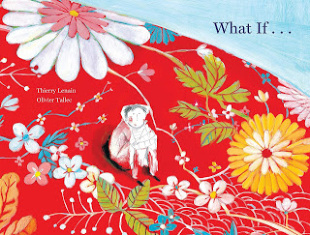This moving and powerful book opens with an epigram by Wendell Berry:
"For humans to have a responsible relationship with the world, they must imagine their places in it. To have a place, to live and belong in a place, to live from a place without destroying it, we must imagine it. By imagination we see it illuminated by its own unique character and by our love for it."
The story opens with a boy sitting atop his island, shown through Olivier Tallec's sumptuous painting as a domed tapestry of flowers. He watches a seagull soar through the sky. If one looks closely, one notices steps — far to the left of him — that go up to the horizon. They're a significant hint about the book's meaning, though a reader likely will not realize that during a first time through its pages.
Page by page, the child sees those things which weigh our hearts down: war, famine, misery, dominant greed, pollution, and more. For each, he asks or implies the title's refrain and offers unique and imaginative solutions, like:
"What if we lasso the clouds
and bring rain to the desert?
What if we dig rivers of water and milk?"
Tallec's pictures carry both the woe (barren trees, silhouettes of fleeing refugees, a nearly skeletal sheep) and hope (the boy mustering all his strength to bring the needed clouds closer to earth).
The second half of the book introduces a few images of beauty and goodness — forests in which the boy imagines walking and listening, people crying whom he imagines hugging — but mostly the book does not cut corners about all that's gone wrong. It's what the boy decides to do — and the place from which he does it — that brings us to a gasp of amazement and hope on the very last page. We glimpse where the steps from the opening page lead.
We honestly cannot say enough good about this book's fit for the current generation of children bravely coming into the world in spite of its mightily tenuous situations. They have powerful vision, hope, creativity, and courage, which What If ... affirms in spades. We might not choose to show this book to children younger than six years, in the recommended six-to-nine-year age span, but we confess that we'd buy it for a grown friend, especially one expecting a baby, because it paints a vision of heartwarming possibilities.
